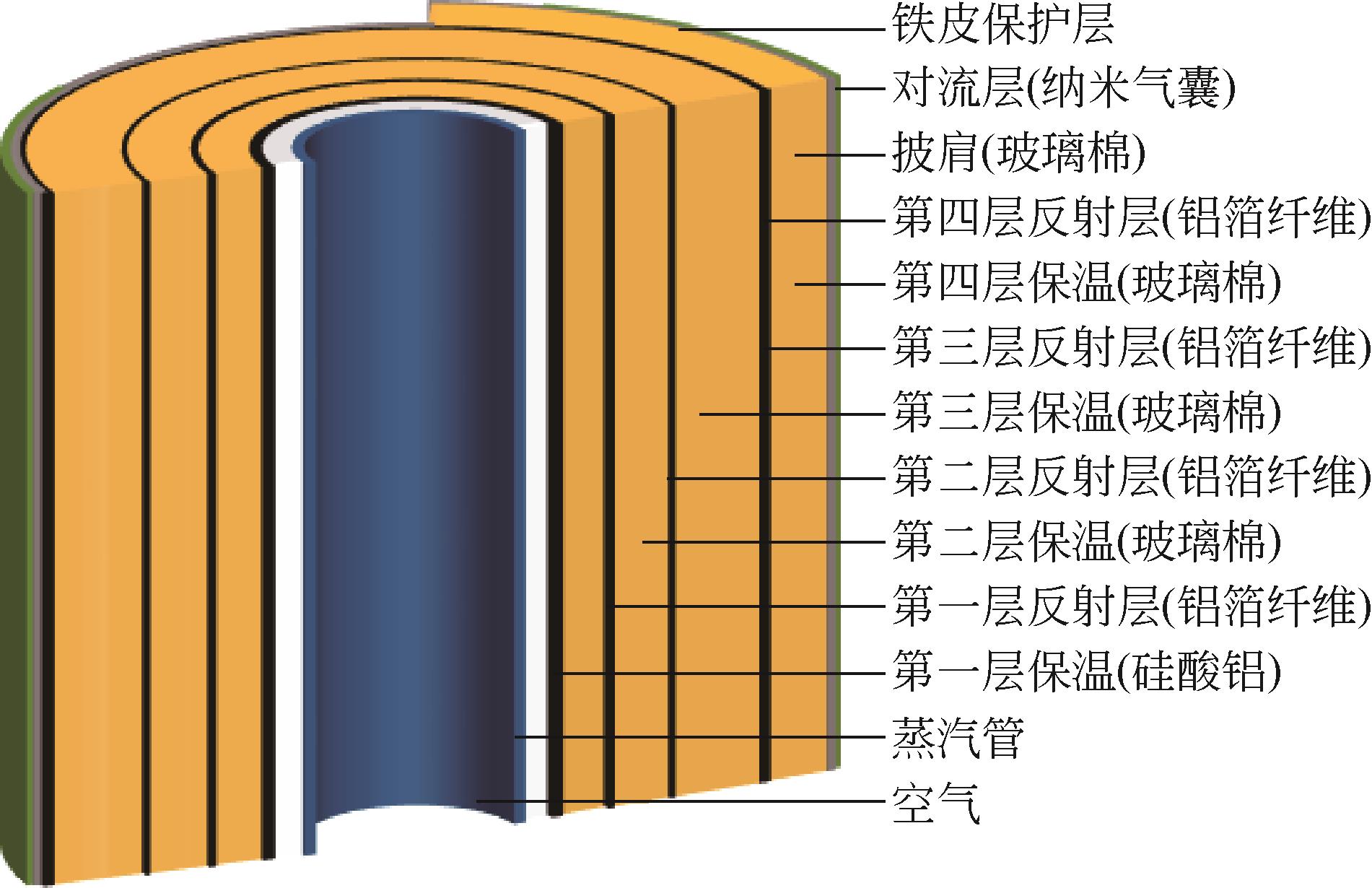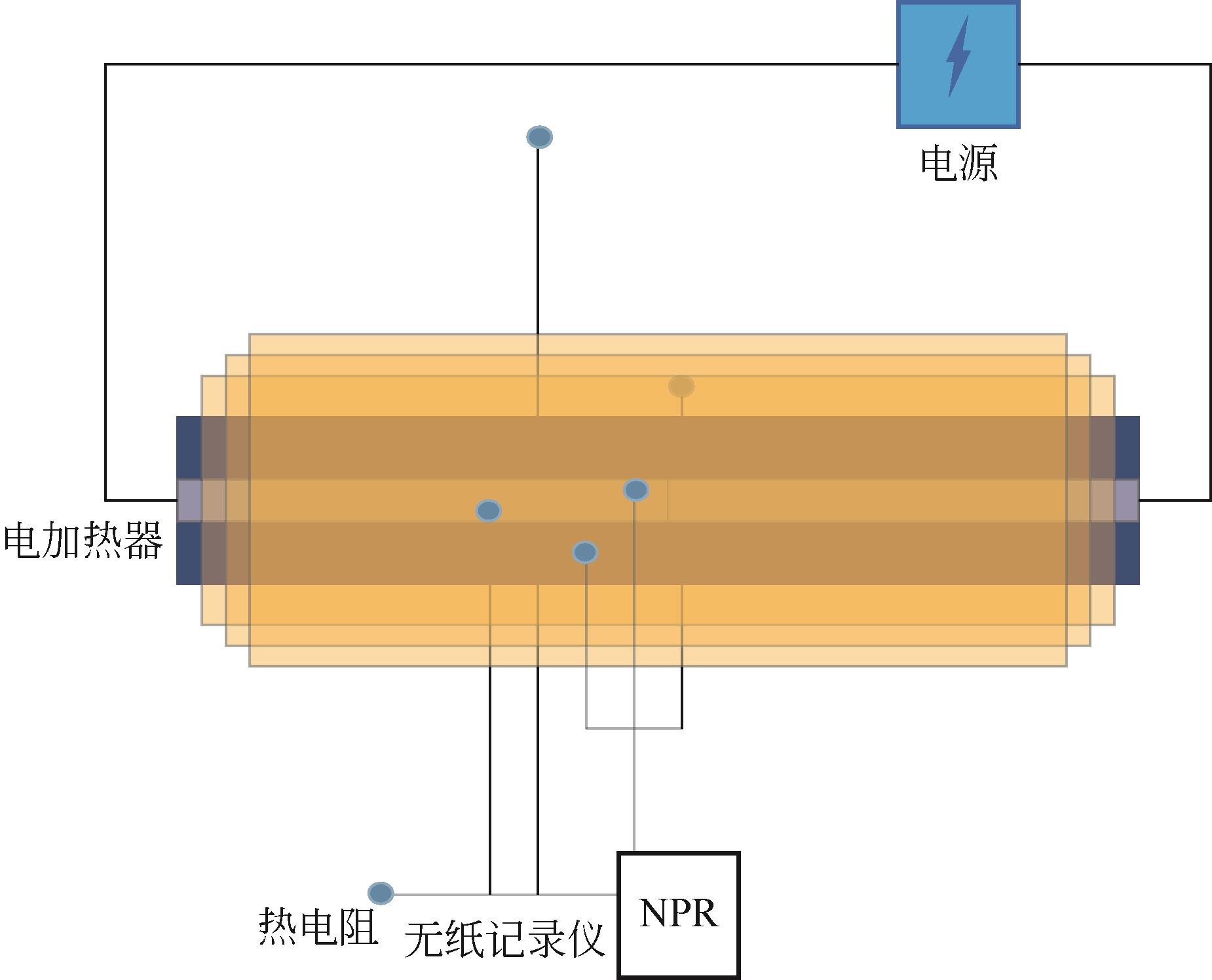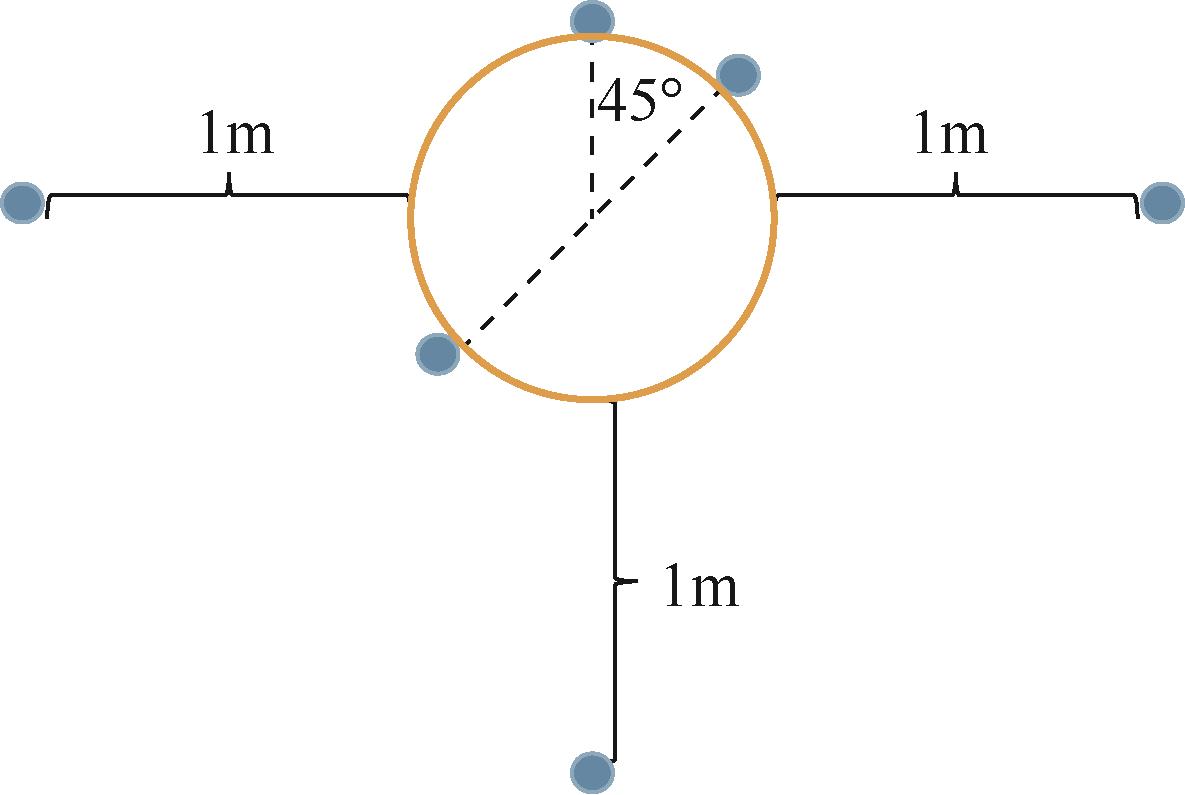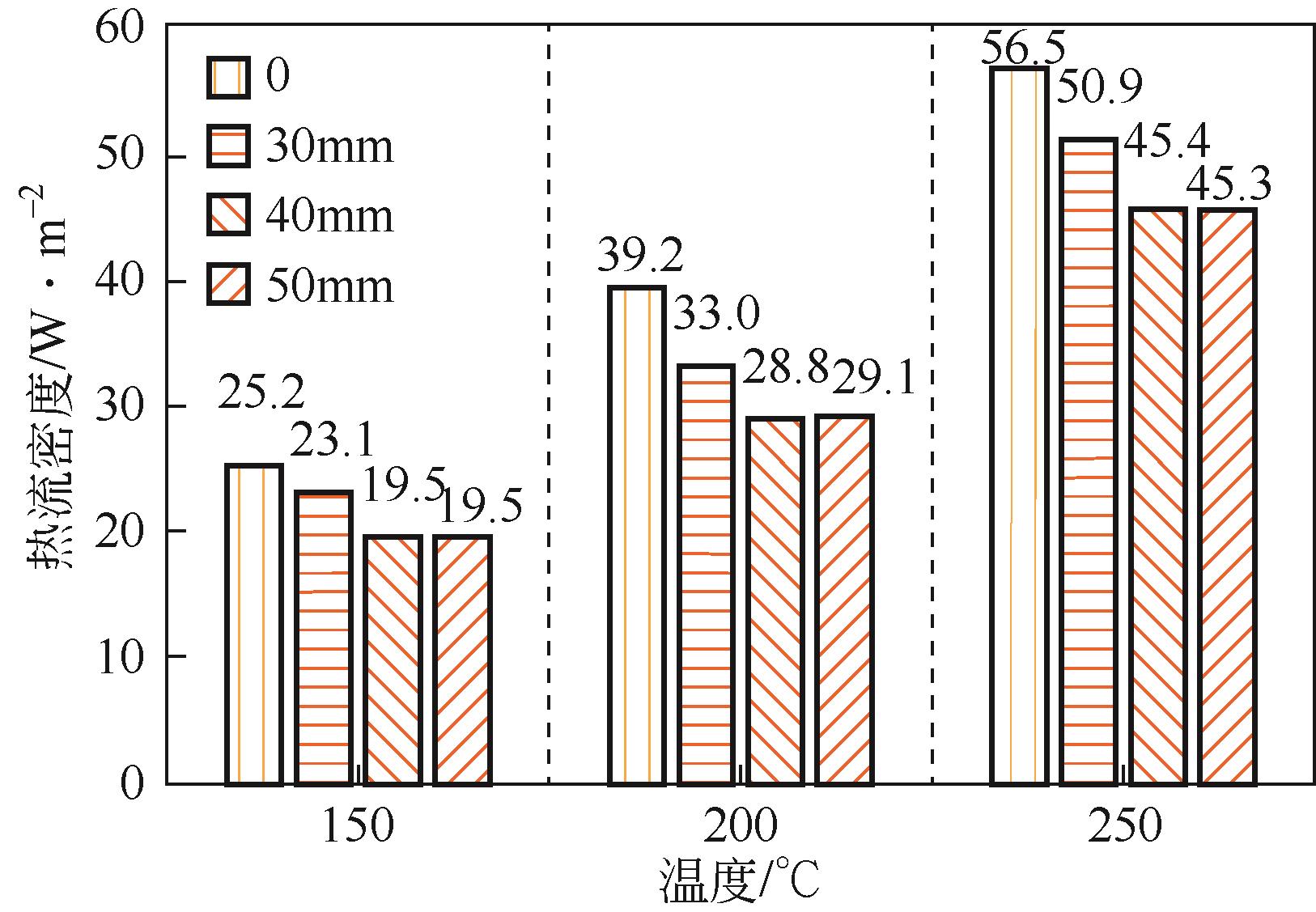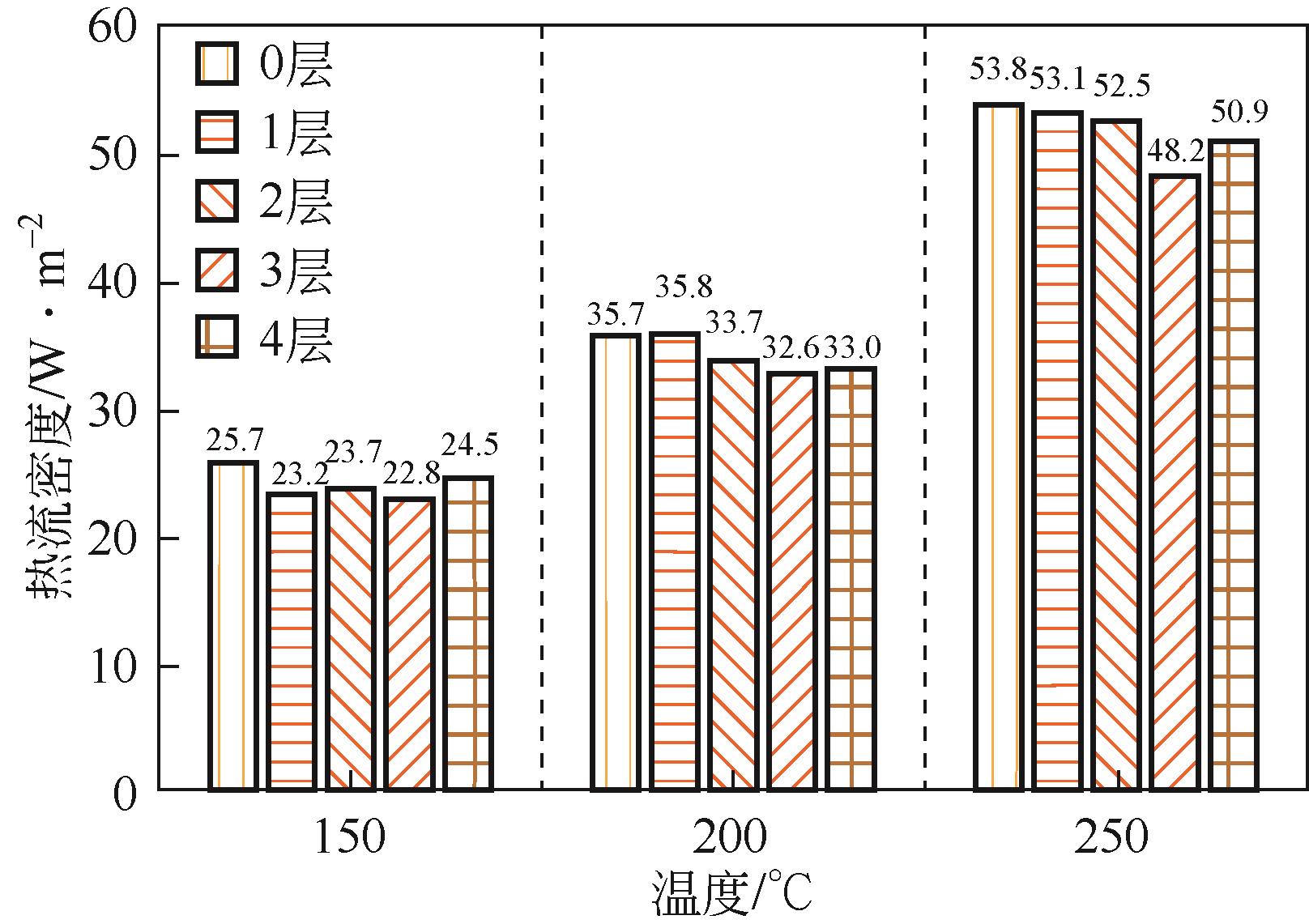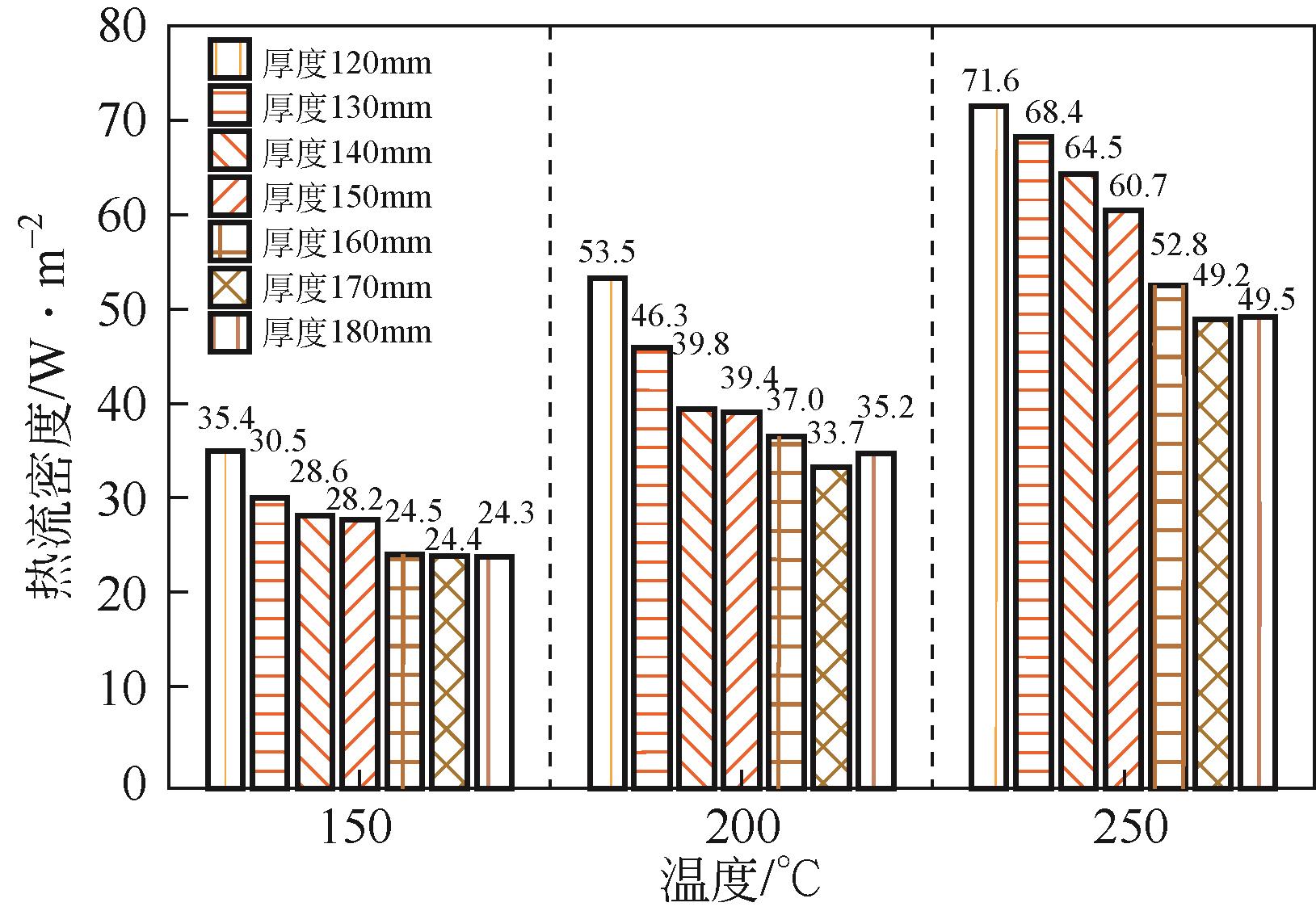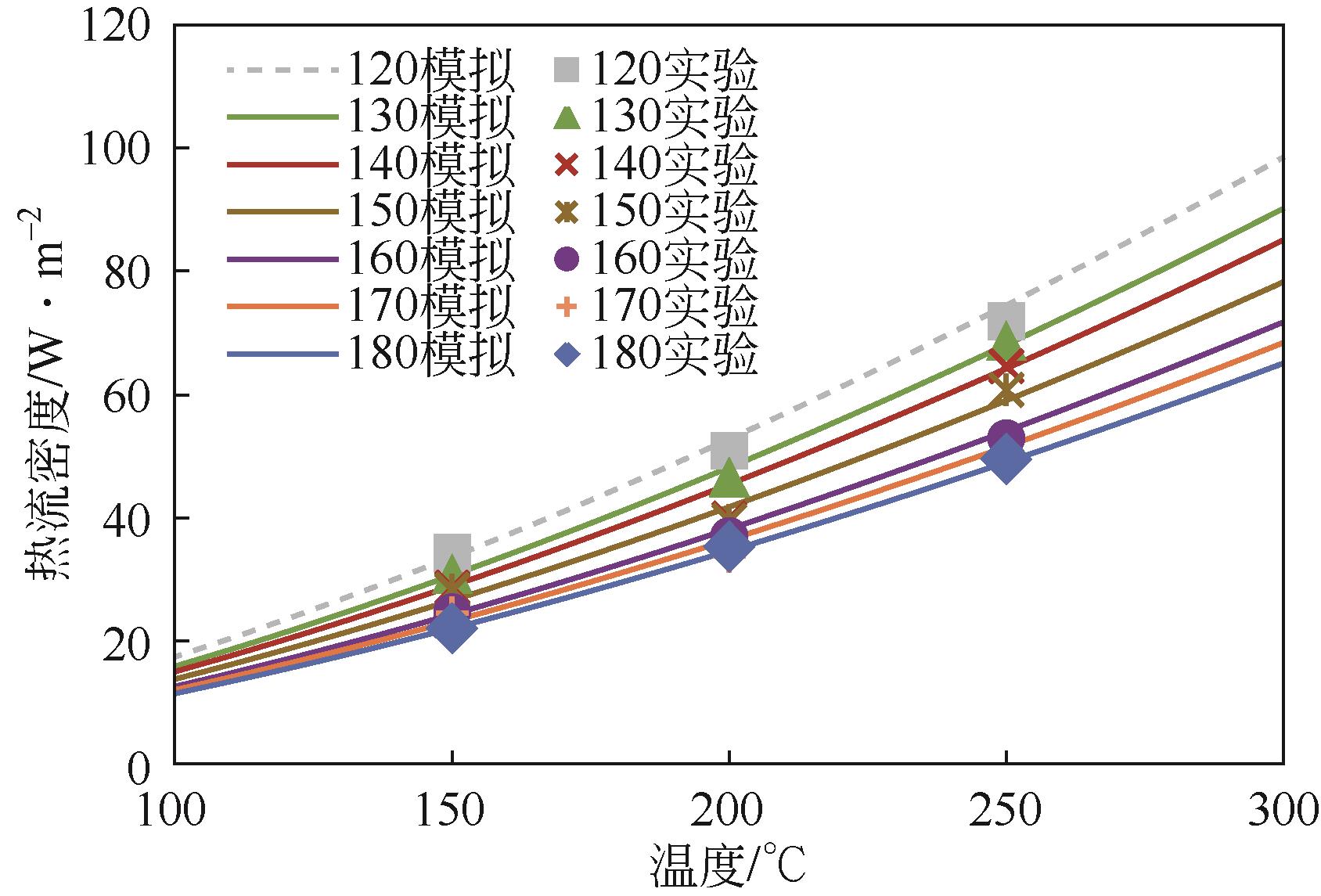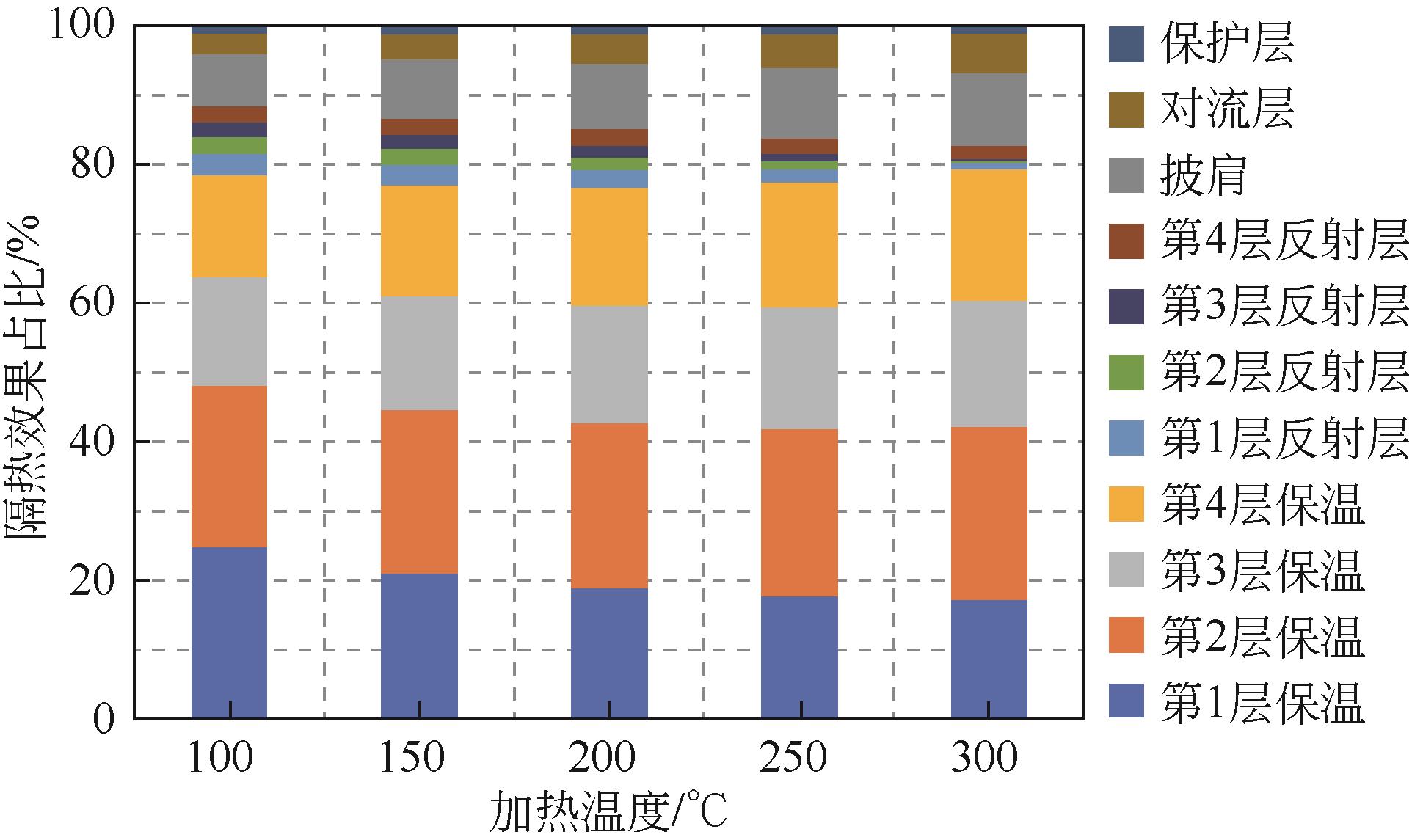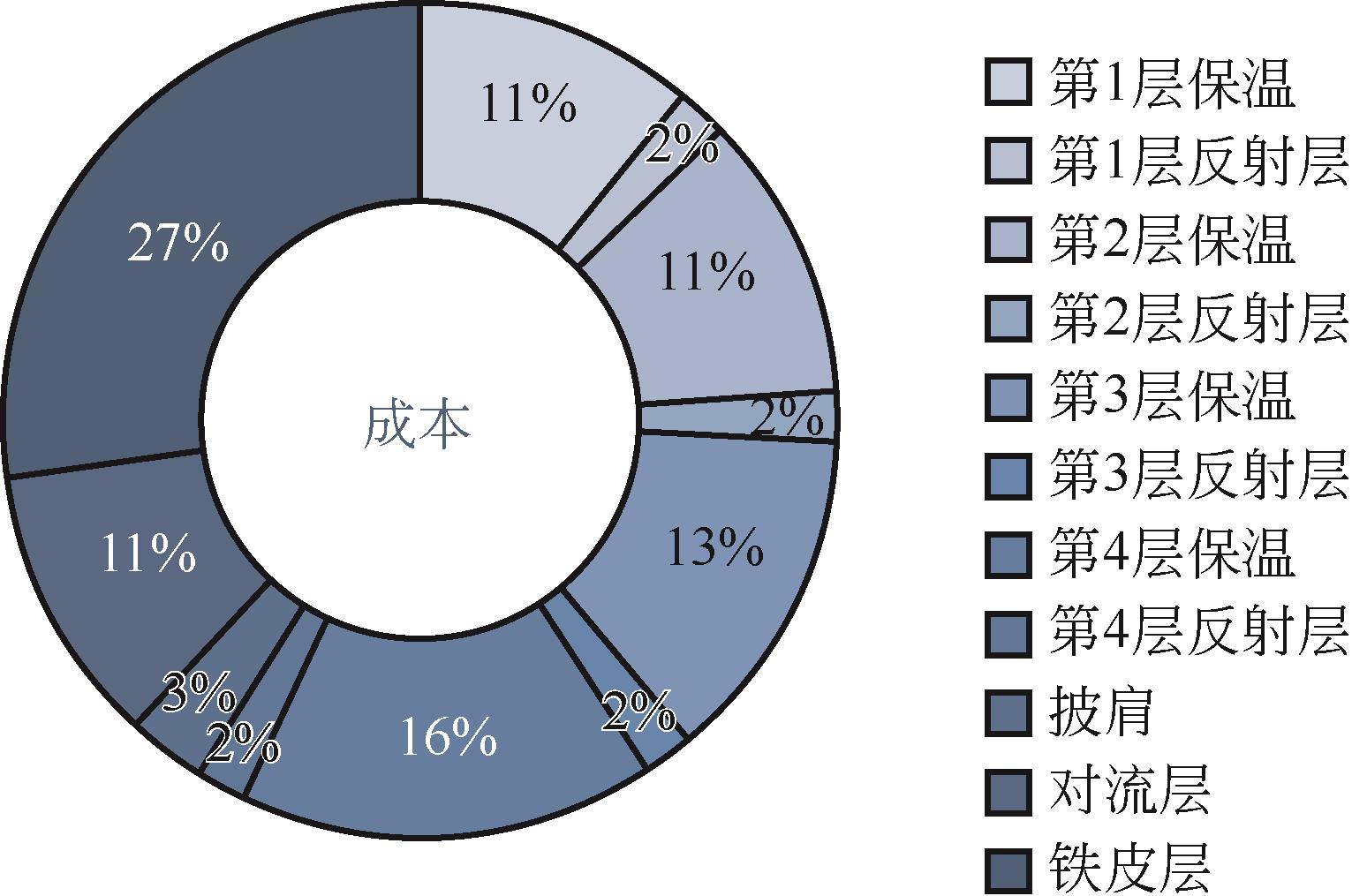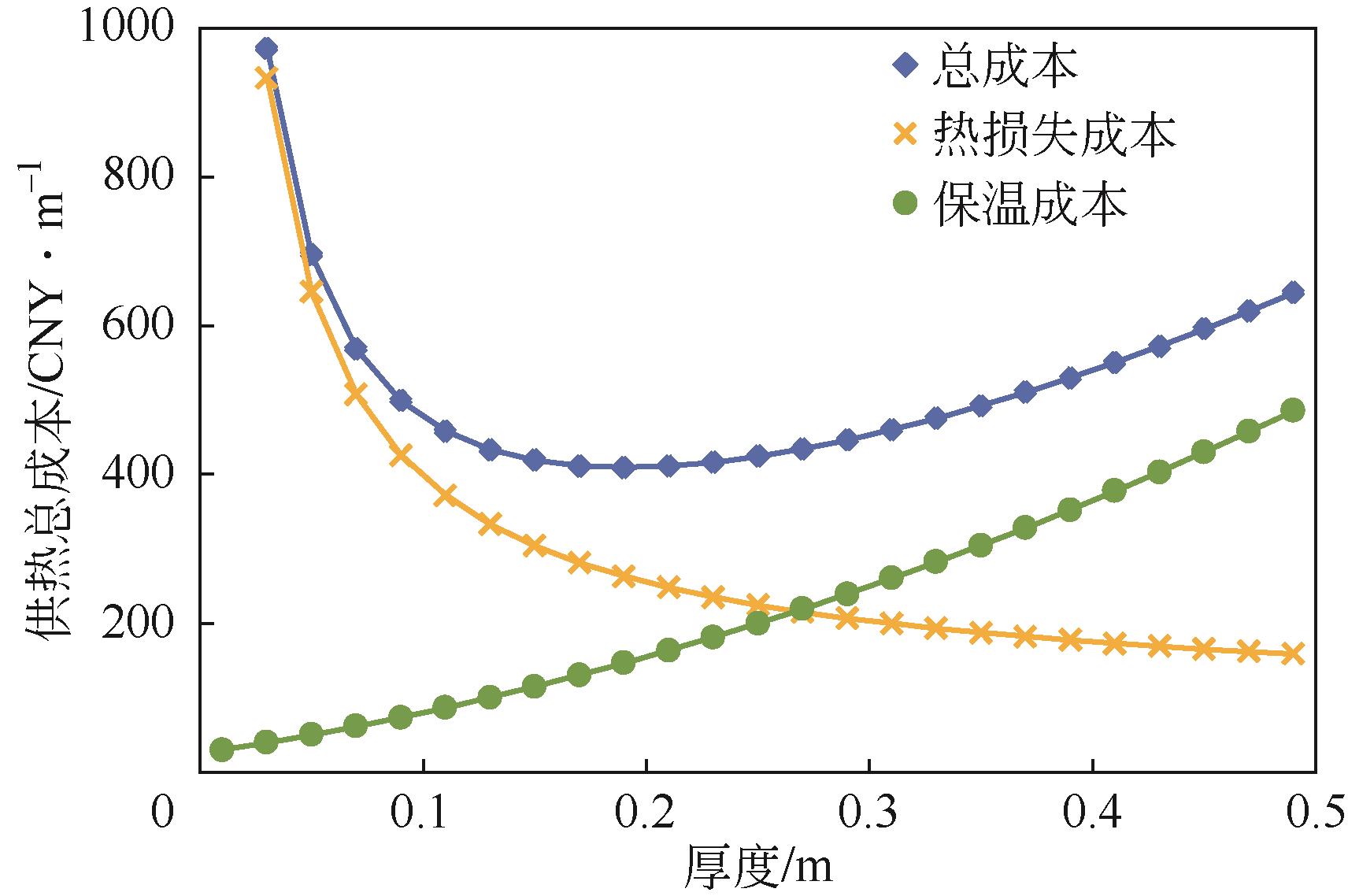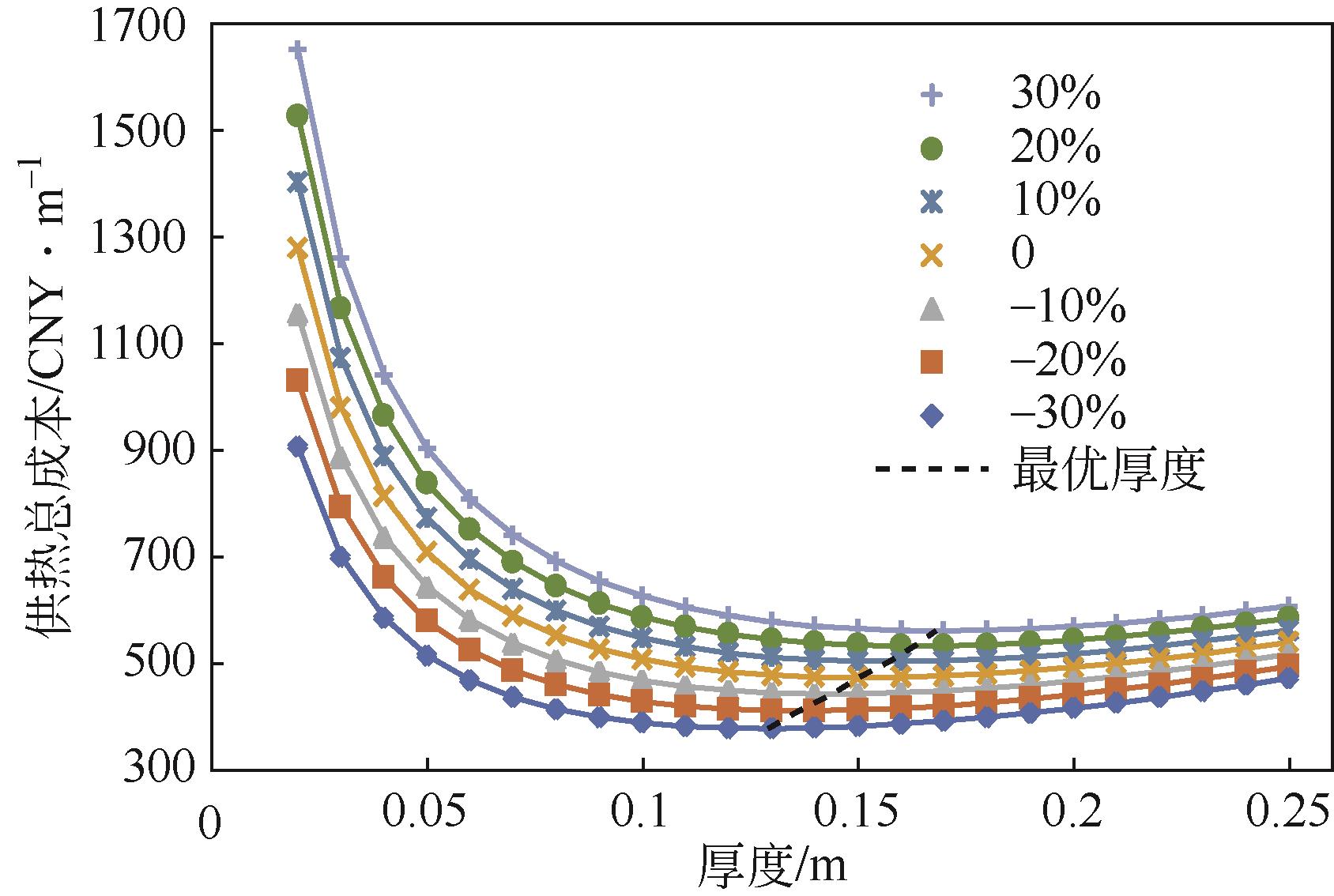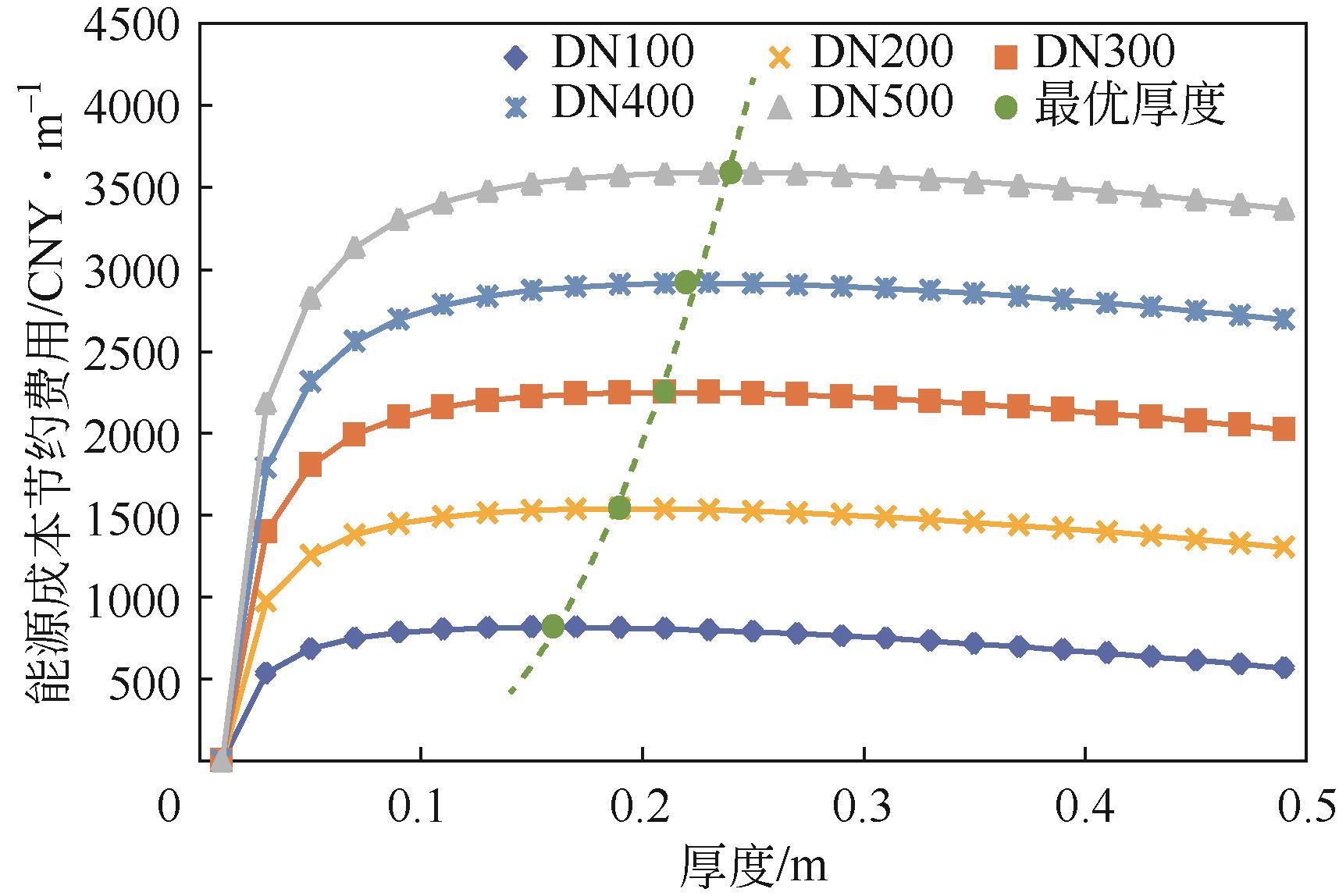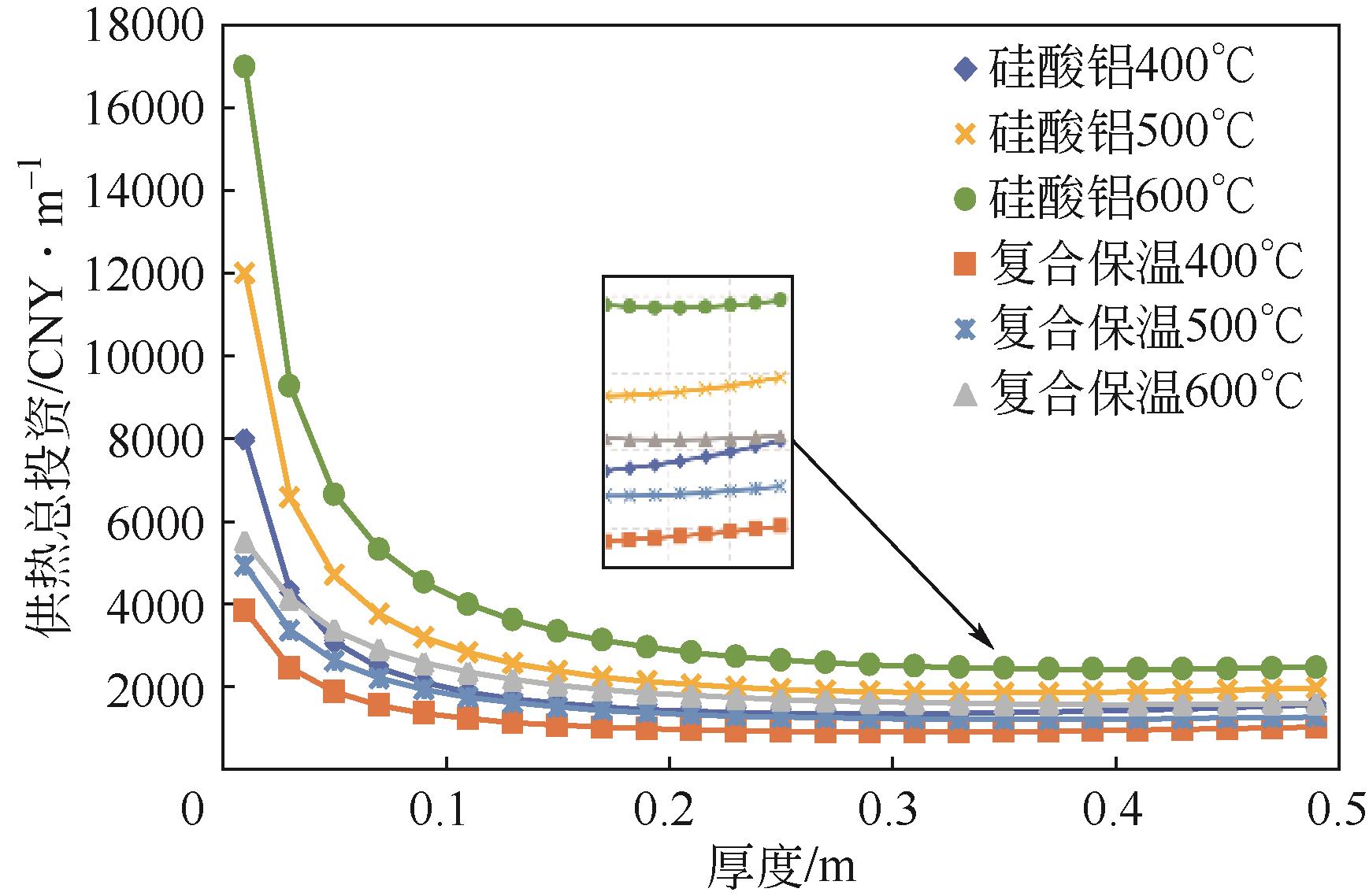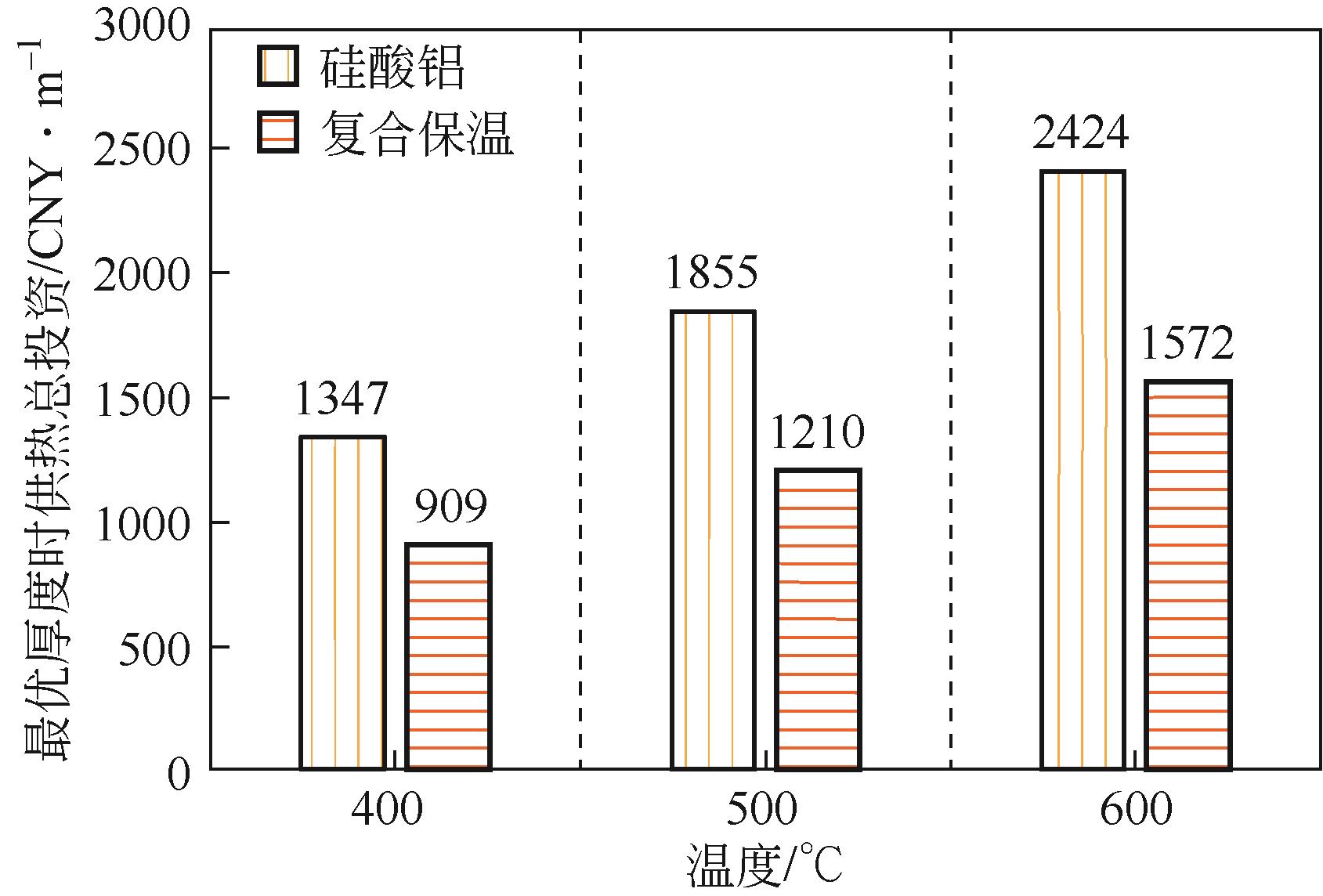化工进展 ›› 2024, Vol. 43 ›› Issue (7): 4164-4172.DOI: 10.16085/j.issn.1000-6613.2024-0215
• 化工园区 • 上一篇
基于实验与仿真的最优蒸汽管网保温结构确定
- 1.煤炭科学研究总院,北京 100013
2.中煤科工清洁能源股份有限公司,北京 100013
3.北京天地融创科技股份有限公司,北京 100013
-
收稿日期:2024-01-29修回日期:2024-04-16出版日期:2024-07-10发布日期:2024-08-14 -
通讯作者:王乃继 -
作者简介:何海军(1979—),男,博士研究生,研究方向为燃烧、节能、环保。E-mail:hehaijun@cctegce.com。 -
基金资助:中国煤炭科工集团有限公司重点项目(2024-ZD0006)
Determination of optimal steam pipe network insulation structure based on experiments and simulations
- 1.China Coal Research Institute, Beijing 100013,China
2.China Coal Technology & Engineering Group Clean Energy Co. , Ltd. , Beijing 100013, China
3.Beijing Tiandi Rongchuang Technology Co. , Ltd. , Beijing 100013, China
-
Received:2024-01-29Revised:2024-04-16Online:2024-07-10Published:2024-08-14 -
Contact:WANG Naiji
摘要:
建立了蒸汽管道多层复合保温结构传热模型,采用DN200mm管道实验研究了不同保温结构和保温材料对隔热性能的影响,根据实验数据验证了数学模型准确性,并以此为基础给出了不同工况下最佳保温方案的确定方法。实验结果显示,管道表面热流密度随着对流层的加入和气囊层数的增加而降低,随披肩厚度和保温总厚度的增加逐渐降低,而反射层数量增加热流密度先降低后升高。传热模型预测结果与实验数据高度吻合,相差不到6%。从经济性分析,不宜采用对流层作为保温材料。最终确定的最佳保温方案能够显著降低系统的供热总成本,最优保温厚度值随管内介质温度和管径的增加而升高。对于温度大于400℃的高温管道,采用复合保温结构相比于单一硅酸铝保温可节省超过30%的投资。
中图分类号:
引用本文
何海军, 王乃继. 基于实验与仿真的最优蒸汽管网保温结构确定[J]. 化工进展, 2024, 43(7): 4164-4172.
HE Haijun, WANG Naiji. Determination of optimal steam pipe network insulation structure based on experiments and simulations[J]. Chemical Industry and Engineering Progress, 2024, 43(7): 4164-4172.
| 序号 | 测量参数 | 测量仪器 | 精度等级 |
|---|---|---|---|
| 1 | 管内温度 | K型铠装热电偶 MIK-WRNK | ±1.5℃ |
| 2 | 层间温度 | Pt100热电阻 MIK-WZP-Y | A级 ±(0.15+0.002|t|)℃ |
| 3 | 环境温度 | Pt100热电阻 MIK-WZP-Y | A级 ±(0.15+0.002|t|)℃ |
| 4 | 周长 | 皮尺 | ±0.01m |
| 5 | 数据记录 | MIK-R6000C无纸记录仪 | 0.2%FS±1d |
表1 测量参数及实验仪器
| 序号 | 测量参数 | 测量仪器 | 精度等级 |
|---|---|---|---|
| 1 | 管内温度 | K型铠装热电偶 MIK-WRNK | ±1.5℃ |
| 2 | 层间温度 | Pt100热电阻 MIK-WZP-Y | A级 ±(0.15+0.002|t|)℃ |
| 3 | 环境温度 | Pt100热电阻 MIK-WZP-Y | A级 ±(0.15+0.002|t|)℃ |
| 4 | 周长 | 皮尺 | ±0.01m |
| 5 | 数据记录 | MIK-R6000C无纸记录仪 | 0.2%FS±1d |
| 序号 | 影响因素 | 保温结构 |
|---|---|---|
| 1 | 对流层 | 厚度180mm,4层保温,4层反射层,30mm披肩单层对流层 |
| 2 | 厚度180mm,4层保温,4层反射层,30mm披肩双层对流层 | |
| 3 | 厚度180mm,4层保温,4层反射层,30mm披肩无对流层 | |
| 4 | 披肩厚度 | 厚度180mm,4层保温,4层反射层,无披肩单层对流层 |
| 5 | 厚度180mm,4层保温,4层反射层,40mm披肩单层对流层 | |
| 6 | 厚度180mm,4层保温,4层反射层,50mm披肩单层对流层 | |
| 7 | 反射层 | 厚度180mm,4层保温,无反射层,30mm披肩单层对流层 |
| 8 | 厚度180mm,4层保温,1层反射层,30mm披肩单层对流层 | |
| 9 | 厚度180mm,4层保温,2层反射层,30mm披肩单层对流层 | |
| 10 | 厚度180mm,4层保温,3层反射层,30mm披肩单层对流层 | |
| 11 | 保温厚度 | 厚度120mm,4层保温,4层反射层,30mm披肩单层对流层 |
| 12 | 厚度130mm,4层保温,4层反射层,30mm披肩单层对流层 | |
| 13 | 厚度140mm,4层保温,4层反射层,30mm披肩单层对流层 | |
| 14 | 厚度150mm,4层保温,4层反射层,30mm披肩单层对流层 | |
| 15 | 厚度160mm,4层保温,4层反射层,30mm披肩单层对流层 | |
| 16 | 厚度170mm,4层保温,4层反射层,30mm披肩单层对流层 |
表2 实验工况
| 序号 | 影响因素 | 保温结构 |
|---|---|---|
| 1 | 对流层 | 厚度180mm,4层保温,4层反射层,30mm披肩单层对流层 |
| 2 | 厚度180mm,4层保温,4层反射层,30mm披肩双层对流层 | |
| 3 | 厚度180mm,4层保温,4层反射层,30mm披肩无对流层 | |
| 4 | 披肩厚度 | 厚度180mm,4层保温,4层反射层,无披肩单层对流层 |
| 5 | 厚度180mm,4层保温,4层反射层,40mm披肩单层对流层 | |
| 6 | 厚度180mm,4层保温,4层反射层,50mm披肩单层对流层 | |
| 7 | 反射层 | 厚度180mm,4层保温,无反射层,30mm披肩单层对流层 |
| 8 | 厚度180mm,4层保温,1层反射层,30mm披肩单层对流层 | |
| 9 | 厚度180mm,4层保温,2层反射层,30mm披肩单层对流层 | |
| 10 | 厚度180mm,4层保温,3层反射层,30mm披肩单层对流层 | |
| 11 | 保温厚度 | 厚度120mm,4层保温,4层反射层,30mm披肩单层对流层 |
| 12 | 厚度130mm,4层保温,4层反射层,30mm披肩单层对流层 | |
| 13 | 厚度140mm,4层保温,4层反射层,30mm披肩单层对流层 | |
| 14 | 厚度150mm,4层保温,4层反射层,30mm披肩单层对流层 | |
| 15 | 厚度160mm,4层保温,4层反射层,30mm披肩单层对流层 | |
| 16 | 厚度170mm,4层保温,4层反射层,30mm披肩单层对流层 |
| 1 | DE ROSA Mattia, BIANCO Vincenzo. Optimal insulation layer for heated water pipes under technical, economic and carbon emission constraints[J]. Energy, 2023, 270(1): 126961. |
| 2 | SURESH Sankar, SUNDAR Mahima, LOKAVARAPU Bhaskara Rao. Optimum insulation thickness in process pipelines[J/OL]. [2024-04-15]. . . |
| 3 | ZHANG Tianhu, LI Aoqi, HARI Qiga, et al. Economic thickness and life cycle cost analysis of insulating layer for the urban district steam heating pipe[J]. Case Studies in Thermal Engineering, 2022, 34: 102058. |
| 4 | TERHAN Meryem. Optimization insulation thickness and reduction of CO2 emissions for pipes in all generation district heating networks[J]. Science Progress, 2022, 105(3): 368504221122287. |
| 5 | SALEM Essam A, FARID KHALIL M, SANHOURY Asmaa S. Optimization of insulation thickness and emissions rate reduction during pipeline carrying hot oil[J]. Alexandria Engineering Journal, 2021, 60(3): 3429-3443. |
| 6 | KÜREKCİ Nuri Alpay, Mehmet ÖZCAN. A practical method for determination of economic insulation thickness of steel, plastic and copper hot water pipes[J]. Journal of Thermal Engineering, 2020, 6(1): 72-86. |
| 7 | KAYFECI Muhammet. Determination of energy saving and optimum insulation thicknesses of the heating piping systems for different insulation materials[J]. Energy and Buildings, 2014, 69: 278-284. |
| 8 | LI Fating, Pengfei JIE, FANG Zhou, et al. Determining the optimum economic insulation thickness of double pipes buried in the soil for district heating systems[J]. Frontiers in Energy, 2021, 15(1): 170-185. |
| 9 | 尚小标, 李广超, 肖利平, 等. 大温度梯度下含锆型硅酸铝纤维板的透波性能[J]. 化工进展, 2023, 42(3): 1551-1561. |
| SHANG Xiaobiao, LI Guangchao, XIAO Liping, et al. Wave transmission performance of zirconium aluminum silicate fiberboard under large temperature gradient[J]. Chemical Industry and Engineering Progress, 2023, 42(3): 1551-1561. | |
| 10 | 徐得华, 靳虎, 徐雪青, 等. 多功能智能型反射隔热涂料的制备与性能表征[J]. 化工进展, 2017, 36(9): 3388-3394. |
| XU Dehua, JIN Hu, XU Xueqing, et al. Preparation and characterization of smart building paints with multiple functions[J]. Chemical Industry and Engineering Progress, 2017, 36(9): 3388-3394. | |
| 11 | PEREIRA David J.S., VIEGAS Carlos, PANÃO Miguel R.O., Heat transfer model of fire protection fiberglass thermal barrier coated with thin aluminium layer[J]. International Journal of Heat and Mass Transfer, 2022, 184: 122301. |
| 12 | 韩申杰, 张恩浩, 卢芸. 建筑用生物质基纤维素保温气凝胶研究进展[J]. 复合材料学报, 2024, 41(1): 108-120. |
| HAN Shenjie, ZHANG Enhao, LU Yun. Research progress of biomass-based cellulose insulation aerogel for building[J]. Acta Materiae Compositae Sinica, 2024, 41(1): 108-120. | |
| 13 | 潘月磊, 程旭东, 闫明远, 等. 二氧化硅气凝胶及其在保温隔热领域应用进展[J]. 化工进展, 2023, 42(1): 297-309. |
| PAN Yuelei, CHENG Xudong, YAN Mingyuan, et al. Silica aerogel and its application in the field of thermal insulation[J]. Chemical Industry and Engineering Progress, 2023, 42(1): 297-309. | |
| 14 | 穆锐, 刘元雪, 欧忠文, 等. 气凝胶复合材料的制备及其保温隔热应用进展[J/OL]. [2024-04-15]. . . |
| MU Rui, LIU Yuanxue, Zhongwen OU, et al. Progress in aerogel composite’s preparation and thermal insulation application[J/OL]. [2024-04-10]. . . | |
| 15 | 熊文婷, 罗启基, 鄢春根. 二氧化硅基气凝胶材料及其制备技术的专利分析[J]. 化工进展, 2024, 43(4): 1912-1922. |
| XIONG Wenting, LUO Qiji, YAN Chungen. Silica-based aerogel materials and their preparation technology from a patent analysis[J]. Chemical Industry and Engineering Progress, 2024, 43(4): 1912-1922. | |
| 16 | WANG Yipu, TU Zhengtao, YUAN Linyang. Analysis of thermal energy storage optimization of thermal insulation material and thermal insulation structure of steam pipe-line[J]. Thermal Science, 2020, 24(5 Part B): 3249-3257. |
| 17 | 闫秋会, 孙晓阳, 罗杰任, 等. SiO2气凝胶提高岩棉和玻璃棉性能的实验研究[J]. 化工进展, 2019, 38(6): 2847-2853. |
| YAN Qiuhui, SUN Xiaoyang, LUO Jieren, et al. Experimental study on improving the performance of rock wool and glass wool by silica aerogel[J]. Chemical Industry and Engineering Progress, 2019, 38(6): 2847-2853. | |
| 18 | 荣雁. 新型绝热材料在稠油注蒸汽管线保温中的应用[J]. 材料导报, 2020, 34(S1): 173-177. |
| RONG Yan. Application of new thermal insulation material in thermal insulation of heavy oil steam injection pipeline[J]. Materials Reports, 2020, 34(S1): 173-177. | |
| 19 | HAYRULLIN Aidar, HAIBULLINA Aigul, SINYAVIN Alex. Insulation thermal conductivity heating networks during transportation thermal energy under dry and moisturizing condition: A comparative study of the guarded hot plate and guarded hot pipe method[J]. Transportation Research Procedia, 2022, 63: 1074-1080. |
| 20 | HUEPPE Christian, GEPPERT Jasmin, STAMMINGER Rainer, et al. Age-related efficiency loss of household refrigeration appliances: Development of an approach to measure the degradation of insulation properties[J]. Applied Thermal Engineering, 2020, 173: 115113. |
| 21 | YU Xiao, TIAN Xuesong. A fault detection algorithm for pipeline insulation layer based on immune neural network[J]. International Journal of Pressure Vessels and Piping, 2022, 196: 104611. |
| 22 | DZHALA Roman, VERBENETS Bohdan, DZHALA Vasyl, et al. Contactless testing of insulation damages distribution of the underground pipelines[J]. Procedia Structural Integrity, 2022, 36: 17-23. |
| 23 | 国家能源局. 发电厂保温油漆设计规程: [S]. 北京: 中国计划出版社, 2019. |
| National Energy Bureau of the People’s Republic of China. Code for designing insulation and painting of power plant: [S]. Beijing: China Planning Press, 2019. | |
| 24 | 翟天龙, 康志勤, 唐海波. 600℃过热蒸汽输送管道保温的实验研究[J]. 化学工程, 2016, 44(5): 38-42. |
| ZHAI Tianlong, KANG Zhiqin, TANG Haibo. Experimental study of insulation of 600℃ superheated steam pipeline[J]. Chemical Engineering (China), 2016, 44(5): 38-42. | |
| 25 | 李小鹏. 直埋蒸汽管道保温层厚度优化与经济性研究[D]. 秦皇岛: 燕山大学, 2021. |
| LI Xiaopeng. Study on thickness optimization and economy of insulation layer for directly buried steam pipeline[D].Qinhuangdao: Yanshan University, 2021. |
| [1] | 赵伟刚, 张倩倩, 蓝钰玲, 闫雯, 周晓剑, 范毜仔, 杜官本. 真空绝热板芯材的研究进展与展望[J]. 化工进展, 2024, 43(7): 3910-3922. |
| [2] | 张巧玲, 马祖浩, 于子元, 刘梓俊, 黄铋匀, 杨振东, 马浩然. 微小通道内超临界R134a流动传热特性[J]. 化工进展, 2024, 43(4): 1667-1675. |
| [3] | 孙超, 艾诗钦, 刘月婵. 考虑物性变化及壳体传热的新型板壳式换热器板程流动传热数值模拟[J]. 化工进展, 2024, 43(4): 1676-1689. |
| [4] | 王彦红, 蒋雷, 薛帅, 李洪伟, 贾玉婷. 预冷通道中超临界甲烷换热特性分析[J]. 化工进展, 2024, 43(4): 1690-1699. |
| [5] | 祝妍妮, 王维, 孙闫晨昊, 魏岗, 张大为. 基于单液滴蒸发的离心喷雾干燥数值模拟[J]. 化工进展, 2024, 43(4): 1700-1710. |
| [6] | 赵吉隆, 郭宇翔, 陈宏霞, 袁达忠, 杜小泽. 竖直铯热管传热特性的实验和数值模拟[J]. 化工进展, 2024, 43(4): 1711-1719. |
| [7] | 钱志广, 王世学, 朱禹, 岳利可. 基于平板热管的高温质子交换膜燃料电池堆启动特性[J]. 化工进展, 2024, 43(4): 1754-1763. |
| [8] | 孙贤, 柳军, 王晓辉, 孙长宇, 陈光进. 含下伏气的第一类天然气水合物藏开发实验与模拟研究进展[J]. 化工进展, 2024, 43(4): 2091-2103. |
| [9] | 禹言芳, 丁鹏程, 孟辉波, 石博文, 姚云娟. 非牛顿流体在叶片式静态混合器中的传热强化特性[J]. 化工进展, 2024, 43(3): 1145-1156. |
| [10] | 见禹, 陈宝明, 宫晗语. 基于分级结构骨架相变储热系统强化传热特性[J]. 化工进展, 2024, 43(2): 649-658. |
| [11] | 朱兵国, 巩楷刚, 彭斌. 垂直管内高质量流速超临界CO2换热特性[J]. 化工进展, 2024, 43(2): 937-947. |
| [12] | 田时泓, 郭磊, 李娜, 宇文超, 许磊, 郭胜惠, 巨少华. 微波加热强化闪蒸工艺的科学基础及发展趋势[J]. 化工进展, 2024, 43(1): 135-144. |
| [13] | 盖宏伟, 张辰君, 屈晶莹, 孙怀禄, 脱永笑, 王斌, 金旭, 张茜, 冯翔, CHEN De. 有机液体储氢技术催化脱氢过程强化研究进展[J]. 化工进展, 2024, 43(1): 164-185. |
| [14] | 肖辉, 张显均, 兰治科, 王苏豪, 王盛. 液态金属绕流管束流动传热进展[J]. 化工进展, 2023, 42(S1): 10-20. |
| [15] | 赵晨, 苗天泽, 张朝阳, 洪芳军, 汪大海. 负压状态窄缝通道乙二醇水溶液传热特性[J]. 化工进展, 2023, 42(S1): 148-157. |
| 阅读次数 | ||||||
|
全文 |
|
|||||
|
摘要 |
|
|||||

